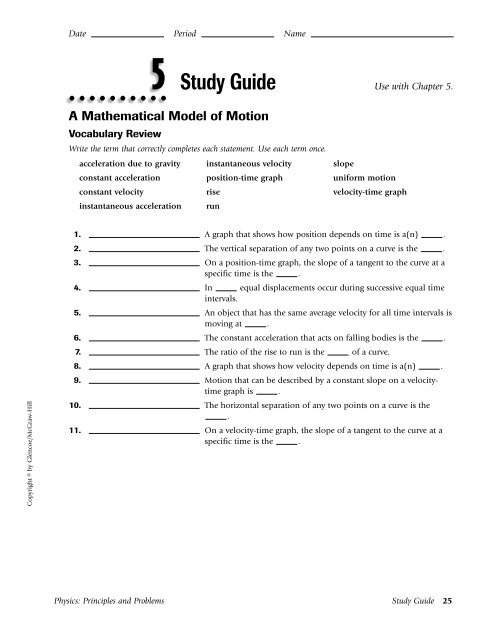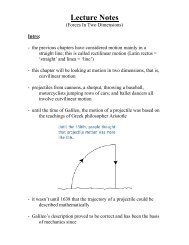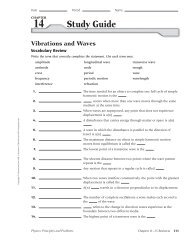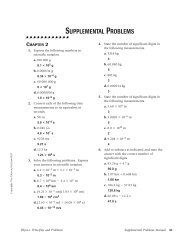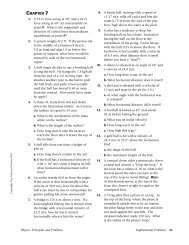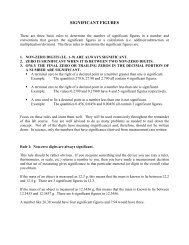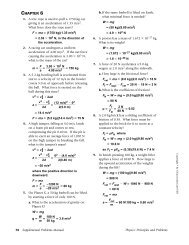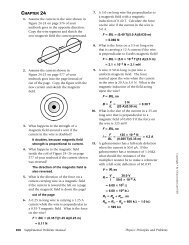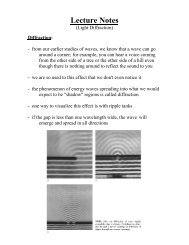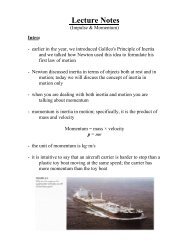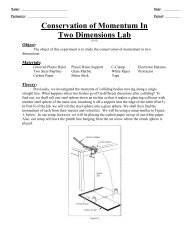Study Guide - Dickey Physics
Study Guide - Dickey Physics
Study Guide - Dickey Physics
- No tags were found...
Create successful ePaper yourself
Turn your PDF publications into a flip-book with our unique Google optimized e-Paper software.
Date Period Name<br />
5<br />
<strong>Study</strong> <strong>Guide</strong> Use with Chapter 5.<br />
A Mathematical Model of Motion<br />
Vocabulary Review<br />
Write the term that correctly completes each statement. Use each term once.<br />
acceleration due to gravity instantaneous velocity<br />
constant acceleration<br />
position-time graph<br />
constant velocity<br />
rise<br />
instantaneous acceleration run<br />
slope<br />
uniform motion<br />
velocity-time graph<br />
Copyright © by Glencoe/McGraw-Hill<br />
1. A graph that shows how position depends on time is a(n) .<br />
2. The vertical separation of any two points on a curve is the .<br />
3. On a position-time graph, the slope of a tangent to the curve at a<br />
specific time is the .<br />
4. In equal displacements occur during successive equal time<br />
intervals.<br />
5. An object that has the same average velocity for all time intervals is<br />
moving at .<br />
6. The constant acceleration that acts on falling bodies is the .<br />
7. The ratio of the rise to run is the of a curve.<br />
8. A graph that shows how velocity depends on time is a(n) .<br />
9. Motion that can be described by a constant slope on a velocitytime<br />
graph is .<br />
10. The horizontal separation of any two points on a curve is the<br />
.<br />
11. On a velocity-time graph, the slope of a tangent to the curve at a<br />
specific time is the .<br />
<strong>Physics</strong>: Principles and Problems <strong>Study</strong> <strong>Guide</strong> 25
5<br />
<strong>Study</strong> <strong>Guide</strong><br />
Name<br />
Section 5.1: Graphing Motion in One Dimension<br />
In your textbook, read about position-time graphs.<br />
Answer the following questions, using complete sentences.<br />
1. How are the position and time of a moving object related on a position-time graph<br />
2. If you decide that the duration of an instant on a position-time graph is a finite period of time,<br />
where is the object during that period<br />
3. What does your conclusion in problem 2 indicate about the motion of the object during that period<br />
4. If the object is moving, what can you conclude about the duration of an instant<br />
5. What is the duration of an instant<br />
In your textbook, read about using graphs to determine position and time.<br />
The position-time graph below shows the position of a teacher at various times as she walks across the front of the room.<br />
The position 0.0 m represents the left side of the room and movement to the right is positive. Circle the letter of the<br />
choice that best completes each statement.<br />
8.0<br />
7.0<br />
Position (m)<br />
6.0<br />
5.0<br />
4.0<br />
3.0<br />
2.0<br />
Copyright © by Glencoe/McGraw-Hill<br />
1.0<br />
0<br />
2.0 4.0 6.0 8.0 10.0 12.0 14.0 16.0 18.0<br />
Time (s)<br />
26 <strong>Study</strong> <strong>Guide</strong> <strong>Physics</strong>: Principles and Problems
5<br />
<strong>Study</strong> <strong>Guide</strong><br />
Name<br />
6. The teacher was walking to the right during the time interval .<br />
a. 1.0–2.0 s b. 6.0–7.0 s c. 10.0–12.0 s d. 7.0–12.0 s<br />
7. The teacher’s displacement for the time interval 0.0–3.0 s is .<br />
a. –3.0 m b. 0.0 m c. +1.0 m d. +3.0 m<br />
8. The teacher’s average velocity for the time interval 1.0–3.0 s is .<br />
a. –1.0 m/s b. +1.0 m/s c. +2.0 m/s d. +3.0 m/s<br />
9. The teacher is standing still during the time interval .<br />
a. 1.0–2.0 s b. 6.0–7.0 s c. 10.0–12.0 s d. 12.0–15.0 s<br />
10. The average velocity for the time interval 10.0–12.0 s is .<br />
a. +1.0 m/s b. +0.5 m/s c. 0.0 m/s d. –0.5 m/s<br />
11. The teacher’s average velocity for the time interval 0.0–15.0 s is .<br />
a. –2.0 m/s b. 0.0 m/s c. +0.067 m/s d. +0.75 m/s<br />
Sketch a motion diagram for each time interval, using the teacher’s position-time graph on page 26.<br />
Time Interval<br />
Motion Diagram<br />
12. 0.0–5.0 s<br />
13. 5.0–7.0 s<br />
14. 7.0–15.0 s<br />
Copyright © by Glencoe/McGraw-Hill<br />
In your textbook, read about using position and time equations.<br />
Refer to the equation d d 0<br />
vt. For each of the statements below, write true or rewrite the italicized part to<br />
make the statement true.<br />
15. The equation contains three quantities.<br />
16. This equation cannot be used if the velocity is changing.<br />
17. The quantity d 0<br />
represents the position at any time.<br />
18. The quantity in the equation that represents the slope of a positiontime<br />
graph for this motion is v.<br />
19. The displacement of the object is vt.<br />
<strong>Physics</strong>: Principles and Problems <strong>Study</strong> <strong>Guide</strong> 27
5<br />
<strong>Study</strong> <strong>Guide</strong><br />
Name<br />
Section 5.2: Graphing Velocity in One Dimension<br />
In your textbook, read about velocity-time graphs and displacement.<br />
Refer to the velocity-time graph of a jogger to complete the two tables.<br />
Velocity (km/min)<br />
0.50<br />
0.45<br />
0.40<br />
0.35<br />
0.30<br />
0.25<br />
0.20<br />
0.15<br />
0.10<br />
0.05<br />
0<br />
A<br />
5.0 10.0 15.0<br />
B<br />
Time (min)<br />
C<br />
20.0 25.0 30.0<br />
Table 1<br />
Segment v t d<br />
A<br />
B<br />
C<br />
Table 2<br />
t Distance Ran Displacement Average Velocity<br />
Copyright © by Glencoe/McGraw-Hill<br />
28 <strong>Study</strong> <strong>Guide</strong> <strong>Physics</strong>: Principles and Problems
5<br />
<strong>Study</strong> <strong>Guide</strong><br />
Name<br />
Section 5.3: Acceleration<br />
In your textbook, read about equations of motion for uniform acceleration.<br />
Complete each table with the values of the variables and initial conditions. Write a question mark for the<br />
unknown variable. If a variable or an initial condition is not needed to answer the problem, write an X. Then<br />
write the equation that you would use to solve the problem. It is not necessary to calculate the answer.<br />
1. A car accelerates from 10 m/s to 15 m/s in 3.0 s. How far does the car travel in this time<br />
Table 1<br />
Variables Initial Conditions Equation<br />
t d v a d 0 v 0<br />
2. A racing car accelerates at 4.5 m/s 2 from rest. What is the car’s velocity after it has traveled 35.0 m<br />
Table 2<br />
Variables Initial Conditions Equation<br />
t d v a d 0 v 0<br />
3. A car initially traveling at 15 m/s accelerates at a constant 4.5 m/s 2 through a distance of 45 m.<br />
How long does it take the car to cover this distance<br />
Table 3<br />
Variables Initial Conditions Equation<br />
t d v a d 0 v 0<br />
Copyright © by Glencoe/McGraw-Hill<br />
4. A ball rolls past a mark on an incline at 0.40 m/s. If the ball has a constant acceleration of<br />
0.20 m/s 2 what is its velocity 3.0 s after it passes the mark<br />
Table 4<br />
Variables Initial Conditions Equation<br />
t d v a d 0 v 0<br />
<strong>Physics</strong>: Principles and Problems <strong>Study</strong> <strong>Guide</strong> 29
5<br />
<strong>Study</strong> <strong>Guide</strong><br />
Name<br />
Section 5.4: Free-Fall<br />
In your textbook, read about free-fall.<br />
Refer to the diagram on the right showing the positions of a ball that was thrown upward<br />
at time t 0<br />
. Complete the tables by indicating if the direction of the velocity and the direction<br />
of the acceleration at each time is or , or if the value of the velocity or acceleration<br />
equals 0.<br />
1. Downward direction is positive.<br />
Rank the magnitudes of the velocities v 0<br />
, v 1<br />
, v 2<br />
,<br />
v 3<br />
, and v 4<br />
, in decreasing order.<br />
Table 1<br />
Time<br />
t 2<br />
t 3<br />
t 1<br />
t 4<br />
t 0<br />
Variable t 0 t 1 t 2 t 3 t 4<br />
2. Upward direction is positive.<br />
Rank the magnitudes of the velocities v 0<br />
, v 1<br />
,<br />
v 2<br />
, v 3<br />
, and v 4<br />
, in decreasing order.<br />
v<br />
a<br />
Table 2<br />
Time<br />
Refer to the velocity-time graph of the vertical velocity<br />
of a ball from the time it is thrown upward from the<br />
top of a building until it reaches the ground. Answer<br />
the following questions.<br />
3. Use a red pencil to shade the area under the<br />
curve that represents the total upward displacement<br />
of the ball.<br />
4. Use a blue pencil to shade the area under the<br />
curve that represents the total downward displacement<br />
of the ball.<br />
5. How could you use the red and blue areas to<br />
determine the height of the building<br />
Velocity (m/s)<br />
Variable t 0 t 1 t 2 t 3 t 4<br />
v<br />
a<br />
10.0<br />
0.0<br />
1.0 2.0 3.0<br />
-10.0<br />
Copyright © by Glencoe/McGraw-Hill<br />
Time (s)<br />
30 <strong>Study</strong> <strong>Guide</strong> <strong>Physics</strong>: Principles and Problems


